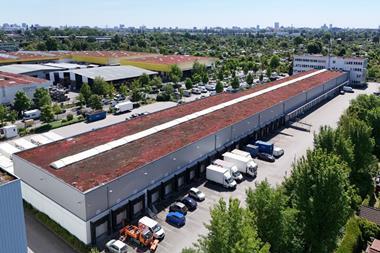Investment potential at the high-risk end continues to abound but the new credit environment is forcing some to change focus. Christine Senior reports
Opportunistic real estate investments have been spectacularly successful recently. With the availability of cheap money to finance development, expanding economic growth - especially in central and eastern Europe - matched by a corresponding lack of commercial real estate to support that growth, the chances to make money through development in the riskier markets have multiplied. Meanwhile, in the more mature real estate markets of western Europe opportunistic investors have been seeking out a wider range of opportunities to exploit.
But recently the credit crunch has applied the brakes on the supply of cheap money. Banks are suddenly unwilling to lend, particularly so on more speculative projects. So it remains to be seen what kind of effect this might have on opportunistic investments, and managers' ability to make money.
At the opportunistic end of the spectrum real estate investing has much in common with private equity investment: managers make money by buying up undervalued real estate, revamping it, adding value and selling it off at a profit. Opportunistic investors take commitments of money from investors and use it as and when suitable investment opportunities are sourced. These higher-risk, higher-return investments are defined by INREV as driven primarily through a capital return, targeting a return of 18.5% a year and having the ability to use more than 70% leverage.
Opportunistic investors could be divided into two camps: those with a macroeconomic view, and those with a bottom-up strategy. The first do broad economic market analysis, decide a particular market is set to grow and invest to take advantage of that growth. The second group work in a particular market to identify opportunities on the ground to invest in. Doughty Hanson falls into the latter camp.
"What we do is bottom-up real estate investing where you buy something, you fix it and you sell it," says John Howard, head of real estate at Doughty Hanson. "It's active management for value creation. I think value creation investors can work in good and bad markets and the macro investors make money by picking the timing and the place to be."
But opportunistic investments can also be sliced and diced in a different way, through the four key strategies they use to make money. The first is through a portfolio of distressed loans collateralised by real estate. Investors buy loans, which may be trading at 50 cents in the dollar, go through the recovery process, and get their hands on the underlying real estate which they can then sell.
"We like those kinds of strategies; they are valued oriented," says Simon Martin, managing director, head of research and strategy at Curzon Global Partners. "You are buying loans but inevitably you are going to end up with lot of the real estate in your hands. You are buying securitised portfolios."
The second opportunity is through leveraged core assets, for instance buying property to yield 8%, but financed at a cost of 4%. "These opportunities only come around when the capital markets are very, very quiet and have been for some time," says Martin. "You don't get many core assets that trade on 8% yields."
The third is a classic private equity play, a public to private transaction. A publicly listed real estate company, listed on one of the major international stock exchanges, falls out of favour and starts trading at a marked discount to its underlying net asset value. The private equity investor takes the company private, and arbitrages the discount to net asset value reflected in the share price.
And finally there is the development option: here the investor is buying the land at full market value, relying on the growth of the market to make money.
"That is the riskiest from an upside perspective of the four classical high-yield strategies," says Martin. "You are not buying something cheap or at a discount and arbitraging it. You are buying something at full market value and hoping that growth in the market exceeds the market's generic price expectations."
Doughty Hanson is particularly committed to identifying opportunities in western Europe. Howard is negative on central Europe: "We think central European markets have strong growth but they also have unlimited supply, which means you are getting a lot of development in a small market. To do large projects in small markets is very risky."
With offices in eight locations in western Europe Doughty Hanson is well placed with experts on the ground to track down investment opportunities. Howard identifies three locations that typify the kind of strategies the company is employing. "We have accumulated a strong portfolio in the UK of large office parks, some of which have further development and expansion capability. We are building residential and office buildings in Italy - we see Italy as an undersupplied market. We went into Stockholm at a time when vacancy rates were high and rental rates had fallen and we see the vacancy rate falling and rental rates rising. That's a good situation for us."
In western Europe, RREEF has been focusing on buying up real estate portfolios from governments looking to reduce debt or from corporates refocusing on their core activities. Recently it bought a large residential portfolio from a German bank, and is currently considering two large sale and leaseback transactions with large European corporates.
Another strategy for RREEF is to buy businesses to get access to the underlying real estate. Two examples are department stores La Rinescente in Italy and Printemps in France, both of which allowed RREEF to get hold of prime real estate close to the cathedral in Milan in the former case and on Paris's premier shopping street, Boulevard Haussmann, in the latter. Both of these transactions enabled the company to get hold of prime real estate that otherwise would not have been accessible on the open market.
There is concern in some quarters that the credit crunch, if it continues, is likely to force a rethink among opportunistic investors on just how they can make money, now that the supply of cheap loans has dried up. In western Europe some are keeping a close eye on the Spanish and Irish property markets, and even the UK, which have seen spectacular rises in property prices. If the credit crunch continues, and borrowers in those markets struggle with their mortgages, there could be opportunities for investors to move in and snap up those distressed loans.
"If we carry on and have a credit crunch and the Spanish housing and Irish housing markets get distressed we might be in the classic model of buying distressed loan book portfolios," says Martin. "I think you might be about to see a big rotation in the strategies typically deployed by high yield and opportunistic funds. You might see them rotate from the more volatile development plays and move back to the more classically value oriented plays like distressed loan portfolios."
In eastern Europe the development strategy still reigns supreme. But as the markets have grown and taken on the characteristics of the more developed western European markets many developers are finding they have to move farther and farther east to find opportunities.
RREEF is focusing on development in central and eastern Europe to take advantage of the remarkable levels of economic growth enjoyed by the region compared with its western European neighbours. It is focused on two sectors, residential in larger cities and retail in secondary locations. The new middle classes throughout CEE find themselves with growing levels of disposable income and want to spend that wealth. They are particularly keen to buy good-quality apartments, which are in short supply.
"There is such an undersupply of good-quality apartments for the middle class it's a trend we believe will continue for the next 10 or 15 years," says RREEF joint CEO for Europe Pierre Cherki. "This is the case in Moscow, St Petersburg and other regional cities in Russia. In Prague or Warsaw, Budapest, Sofia and you see similar trends. I cannot see any one of these markets where it is saturated."
In retail developments RREEF is focusing on the secondary and tertiary cities, because
in the capitals opportunities have dried up. "Opportunities are changing," said Cherki. "You started from the capitals, moved to cities of 250,000 to about 500,000 and now developers are starting to look at cities of between 50,000 and 100,000 people that don't have any retail offering."
Unlike many investors Martin is wary of the development story in central and eastern Europe. "There a lot of guys of looking at the market and saying if I get the right location, the right demographic profile, the right growth profile and I can find a market that has some degree of supply constraint or there's not a lot of new development competing with me then they're willing to contemplate doing development," says Martin. "I have to say I think that's a pretty risky strategy right now. But it's clearly where a lot of people have been focused for the last 12 to 18 months."
Institutional investors such as pension funds are showing varying degrees of interest in European opportunistic real estate funds. UK pension funds are investing, but the usual route in is via a multi-manager or fund of funds arrangement, to get the
necessary diversification.
"You'd want to put together a whole series of these, and that is typically done through the fund of funds manager," says Greg Wright, a principal at Mercer. "They will usually let the fund manager have the mandate to invest in these sorts of vehicles."
European pension funds might be more inclined to invest directly because they are not such big users of funds of funds, he says. But it is the US and Australian pension funds that are really showing the most enthusiasm for these funds.
"The US clients we have that invest in Europe probably go only for these sorts of vehicles," says Wright. "They seem less interested in the core-type approach. I think they think they can get that from the US and think it's a lot of effort to try to find European funds - you have to go through extra tax and legal arrangements and so on. Their view would be if you are going to do that it might as well be through the higher-returning end to make it worthwhile."
Dutch pension investment company Mn Services has €800m invested in non-listed opportunistic funds investing in Europe, targeting a net return of 15-16%. Senior real estate manager Bas van den IJssel says most of this is invested in western Europe, purely because that reflects the relative size of the market.
"If you take Europe as a whole the real estate market representing central Europe would be perhaps 5-10%," he says. "So to be in line, all things being equal, then you invest 10% in that part."
But the two regions do take on different characteristics, due to their different levels of maturity, he adds. "Because CEE is emerging the stock has to be developed. In London, Paris, Madrid and so on you can have older buildings that change from offices to residential and now change back to office because prices are higher. These value added opportunity plays you can't play in those countries, because the stock isn't there so you just have to build."
CalPERS, the California public employees pension fund which is the largest pension fund in the US, is investing in European opportunistic real estate funds. With a real estate portfolio valued at more than $20bn, CalPERS has recently shifted its portfolio allocation to give a 50% allocation to international real estate, with a staff discretionary range of 10% to 60%. It has also recently allocated $75m to Harbert Management to be invested in opportunistic European real estate.
Clark McKinley, a spokesman for the fund, explains how CalPERS views opportunistic real estate: "By "opportunistic" we mean highly undervalued properties due to poor management, limited current income; prospects of turnaround through professional management or full-scale development; and substantial capital appreciation as a result of income creation."
Nevertheless CalPERS sees Europe alongside the US as less fertile soil to yield investment opportunities: "We see more than 50% of the best opportunities in real estate outside of the US, but more so in Asia and even Latin America than in the US and Europe," McKinley says.












